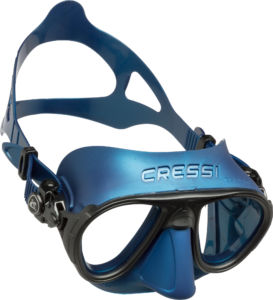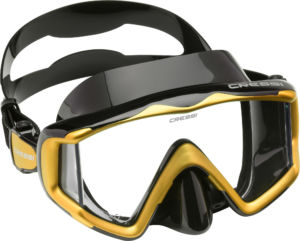It’s easy to feel overwhelmed when you buy your first scuba diving mask and that’s understandable—there are so many options and many new, unfamiliar terms to contend with. Here’s a guide to buying your first scuba diving mask to help you choose what’s right for you.
Check for fit
The first step when selecting a mask is to check for fit. Consequently, it’s best to go into your local dive shop to try them on, rather than ordering online. To check if a mask fits well, sweep any hair off your face and gently hold the mask on your face in its proper position. There’s no need to put the strap around the back of your head. If the mask fits well, it will stay on your face when you breathe in through your nose.
Slowly and gently inhale through your nose with the mask in place. You will feel a slight suction as the air volume in the mask decreases. If the mask fits, there will be a complete seal all the way around the silicone skirt (the part of the mask that rests on your face).
The mask should feel comfortable and there should be no pressure at the top of your nose in the area between your eyebrows.
Does brand matter?
Yes and no. What matters most is that the mask fits you well and is comfortable. That said, certain manufacturers have a reputation for quality products that last for years and years. Buying a cheap scuba diving mask because the price appeals is often a false economy because the mask may not last as long.
Some of the most popular and reliable scuba equipment brands include Cressi, Scubapro, Aqua Lung, Atomic Aquatics and Mares, among others. This list is not exhaustive and there are other quality brands. These, however, are some of the major manufacturers you’ll encounter.
Know your terminology

It’s important to know what terms mean as you select your mask, for example, you may see or hear the terms “low-volume,” or “low-profile.” Low-volume means that the mask has a lower air volume than a ‘normal’ mask, and low-profile means that the mask sits closer to your face. As you can imagine, masks that are closer to your face also have a lower air volume, so these terms are essentially interchangeable.
The idea behind a low-volume mask is that it’s easier for the wearer to clear the water — less air volume means less room for water and so less displacement is needed. However, some people find it makes no difference. Either way, your clearing technique is more important than your masks’ construction.
Purge valve
Some scuba masks have a purge valve on the nose. We recommend you avoid these masks as they are not suitable for scuba diving — the purge valve really just means an added vulnerability. These masks are fine for snorkeling, but many snorkelers prefer a regular scuba diving mask.
Skirt
A mask’s skirt is the soft silicone that runs around the whole mask and allows it to comfortably seal on your face. Look for soft, supple silicone when making a purchase. You’ll notice that the skirt has a double seal at the top of the mask and a single seal at the bottom so you can easily clear it of water.
Color is not important but plenty of people have a preference between clear and black silicone. These days, many masks feature brightly colored silicone.
Anti-fog
This is little more than a marketing ploy, unfortunately. All masks fog when they’re new unless you have properly treated them. You have a couple of options for treating your new mask: scrub the interior glass several times with toothpaste and an old toothbrush or use a lighter to carefully burn away the thin protective film covering the glass.
Tempered glass
Any scuba diving mask worth its salt(water) has tempered-glass lenses or windows (these terms are used interchangeably). Plastic lenses are not reliable in a scuba diving context and should only be used for snorkeling.
What kind of mask should you get?
There are several types of masks on the market; these are the ones you’ll likely encounter.
Panoramic and wide-view masks

These masks have additional lenses or windows on the side, with the idea that your field of vision increases. Despite these claims, you’re more likely to see divers with regular masks than panoramic options.
Single-lens or dual-lens masks
Some masks have two separate lenses or windows (separated at the nose) while others have one continuous lens. Single-lens masks may help with depth perception. This is really a matter of personal preference and you will see divers with both types.
Prescription dive masks
As the name suggests, prescription dive masks include optical lenses to correct nearsightedness or farsightedness, exactly like a pair of glasses. Some divers prefer contact lenses and a regular mask while others choose to use a dedicated prescription mask.
How much do scuba diving masks cost?
It completely depends on the brand and the specifications and/or features. A basic quality mask from Cressi, for example, can go for around $45. Top of the range masks can cost up to $150 or even more.
For your first ever scuba mask, it’s probably best to choose a basic model so you can get a feel for what you like and don’t like — you can always upgrade later.
We hope this guide to buying your first scuba diving mask was helpful and the terminology explanations cleared up some of your questions. Happy diving and mask shopping!

